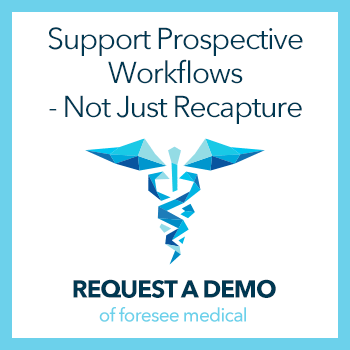Retrospective Review Pitfalls
With the DOJ’s heightened focus on risk adjustment compliance, many Medicare Advantage Organizations (MAOs) are finding it challenging to optimize their risk adjustment coding while adhering to the compliance guidelines set by CMS.
Observing the comments and actions from CMS and the DOJ, it is evident that coding directly from the patient visit is the preferred method for documenting a member's disease burden. However, it is widely acknowledged within the industry that MAOs often depend on retrospective chart reviews as the primary method for identifying conditions that were not coded during the patient encounter. These organizations either hire staff or outsource these reviews to identify and add unreported conditions missed at the point of care. This retrospective review process is costly and can sometimes lead to a disconnect between the treating physician's coding and the MAO’s interpretation of the patient’s disease burden. It’s somewhat paradoxical that the coding by the treating physician does not fully capture the patient's disease burden, yet retrospective chart reviews remain a prevalent practice.
When treating physicians incompletely document patient disease burden by under-coding or miscoding patient encounters, an expensive cycle of retrospective review audit is required. Providers are required to transmit records to health plans, or contracted risk adjustment auditors, which increases a medical groups administrative burden. The plan in turn may pay millions of dollars to support an effective retrospective review process and even so, compliance issues abound, such as reporting ailments that have resolved or were incorrectly coded. Since CMS has determined that the health plan is responsible for “the accuracy, completeness, and truthfulness of the submitted data”, poor compliance could result in significant liability issues for those MAOs.
Prospective Review: Always better if the treating physician is involved
Most physicians would love to have risk adjustment coding help if they could afford it. I’ve never met a medical provider that wants to focus on administrative or billing issues concurrent with a patient visit. The challenge is that many treating physicians don’t have the coding manpower to assist them with a prospective risk adjustment review prior to a patient encounter. Even if they have coding staff, those coders are typically overworked and therefore the prospective review, and the benefits of a prospective payment system can easily slip through the cracks.
Some MAOs use prospective review but instead of having the treating doctor participate in the process, they contract with third party vendors who may not be familiar with the patient’s history. Those vendors may report conditions on pre-populated forms supplied by the health plan. In some of these cases there is pressure on the vendor to code disease without support documentation. This is not surprising because the vendor is siloed away from the patient’s host EHR system. Those vendors may rely on healthcare analytics data not verified through medical records and instead only confirmed anecdotally from patient histories and then coded by those vendors.
Everyone’s Risk Adjustment Wish List
The treating provider should code accurately at the point of care
Assist physicians with risk adjustment coding prospectively
Have evidence in the medical record that supports coding decisions
Display evidence that may support a code at the point of care
Limit expensive and burdensome retrospective review
Increase the productivity of prized risk adjustment coding resources
Achieving the Risk Adjustment Wish List
With the advent of NLP technology, applications can utilize artificial intelligence in healthcare to finally make our risk adjustment wish list achievable. Risk adjustment software can now work with the patient’s EHR record real time to improve the accuracy and speed of the prospective review process. Treating physicians can now use clinical decision support built into risk adjustment software to improve compliance with CMS rules. Treating physicians can “get it right the first time” because the right way is actually less hassle.
See how ForeSee Medical’s risk adjustment coding software can help you eliminate retrospective review and capture every appropriate HCC code at the point of care - getting you the reimbursements you deserve.
Blog by: The ForeSee Medical Team




